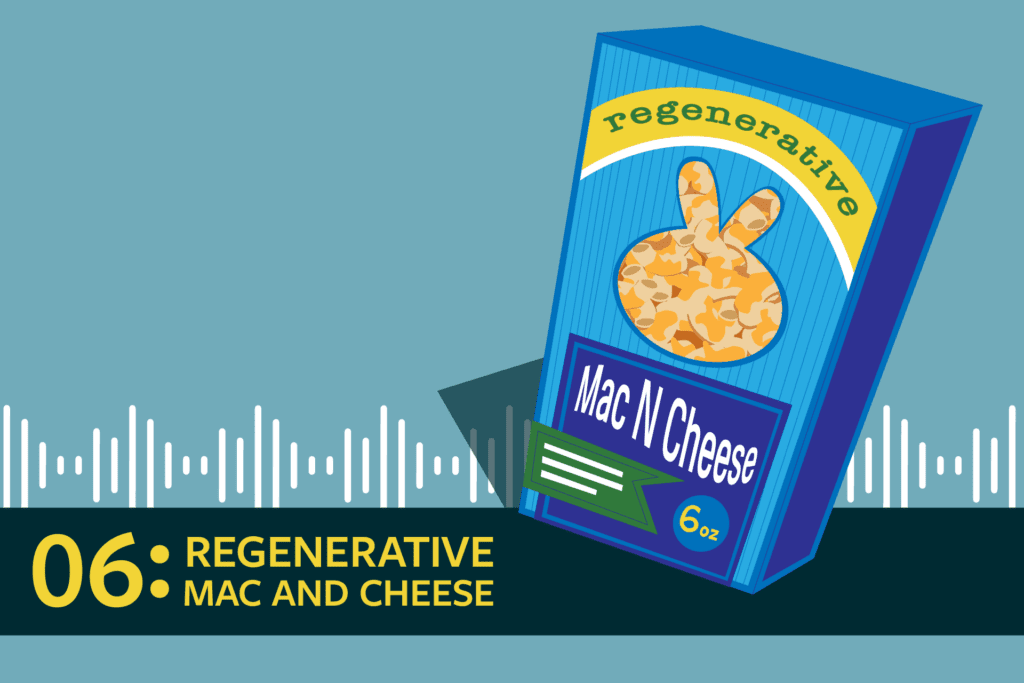Can private grants fill regenerative agriculture’s federal funding gap?
Adopting more environmentally sound practices on the farm doesn’t come cheap. That’s why, in early February, Farmers Business Network (FBN) launched a new land loan program designed to incentivize regenerative agriculture by offering discounted loan rates to farmers who adopt — or have already adopted — practices that improve soil and water health. Although regenerative agriculture still lacks an official definition in most of the U.S., generally speaking it focuses on restoring and enhancing soil health, increasing biodiversity, and improving the overall sustainability of farming systems, often by embracing land management techniques pioneered and preserved by Indigenous people.
In theory, farmers can access funding for some of those practices under the U.S. Department of Agriculture’s (USDA) conservation programs. But with many of those programs already defunded by the Trump administration and more cuts expected, there aren’t as many resources as usual. Meanwhile, there also aren’t specific government funds to help farmers transition to regenerative farming like there are for farmers transitioning to organic. This gap in public funding leaves a hole that private financing like the FBN pilot and other programs in the private sector could help fill.
Dan English, general manager at FBN, describes the initiative as the start of “a much bigger effort to reward farmers for taking these practices.” If the pilot proves successful, it could lay the groundwork for a broader financial model that supports regenerative agriculture at scale.
The pilot round is being funded by the Walton Family Foundation, the philanthropic arm of the family that founded Walmart, and will allocate a total of $750,000 to a cohort of 20 farmers. The farmers have seven years to repay the loans. If the program is successful, it may be funded by other groups. FBN was originally hopeful that government programs could contribute, but given the current administration, that hope now seems unlikely to be realized.
A growing private funding landscape
The FBN land loan program is part of a broader trend of private-sector initiatives aimed at filling the financial gaps for farmers transitioning to regenerative agriculture. These programs offer a variety of funding structures — including grants, loans and direct payments — designed to make regenerative practices more accessible. While some initiatives provide upfront capital through community- or investor-backed loans, others award grants or offer performance-based payments tied to environmental outcomes like carbon sequestration.
Zero FoodPrint (ZFP) awards carbon-sequestration grants to farms by pooling and distributing funds from different parts of the food system. Unlike loans or carbon-credit programs, ZFP’s Restore Grants directly fund climate-smart practices like composting, cover cropping and hedgerow planting (which provides habitats for wildlife and helps mitigate soil erosion). This model makes regenerative transitions more accessible, particularly for small and mid-size farms that might struggle with debt-based financing. ZFP’s grants are awarded based on the “cost per ton” of carbon sequestered, making them an attractive option for farms looking to implement high-impact regenerative practices.
Steward Loans provides flexible capital to small and mid-size farms practicing regenerative agriculture. Unlike traditional bank loans, Steward’s funding model is built on community-driven lending, allowing individual investors to directly support farmers. This approach helps farms that may not qualify for conventional loans gain access to working capital.
The Regenerative Agriculture Foundation (RAF) focuses on providing grants to organizations and farmers implementing regenerative projects. Rather than loans, RAF’s funding helps to support long-term adoption of regenerative practices through education, research and on-the-ground initiatives.
Cargill RegenConnect and Indigo Ag Carbon Programs offer direct payments to farmers who implement soil-health practices that sequester carbon, selling the resulting credits to corporations looking to offset emissions. While these carbon programs can be lucrative, they have also faced criticism for unclear payment structures and eligibility requirements. Given the company’s history of contributing to deforestation and industrialized farming, the effort may serve more as a greenwashing stint than a systemic shift — though the corporation is aiming to support farmers in transitioning 10 million acres of land in North America into regenerative farms by 2030.
How the FBN land loan works
The FBN land loan program builds on FBN’s existing RAF initiative, which launched a couple of years ago with backing from Environmental Defense Fund (EDF) research. That research found that farmers would be more likely to adopt regenerative practices if they received financial incentives, particularly in the form of lower interest rates.
To qualify, farmers must support soil and water health through approved practices such as no- or low-till farming, winter cover cropping or other soil conservation methods recognized by the Natural Resources Conservation Service; meet nutrient management requirements to maintain a healthy nitrogen balance; and undergo verification to ensure ongoing compliance. Farmers who have already transitioned to regenerative agriculture can also apply.
The program is currently limited to corn, soybean and wheat farmers within the Mississippi River watershed, a region where water pollution from conventional farming has been a major issue. While there’s some debate among regenerative farmers whether farms focusing on large swaths of a single crop can be fully regenerative — many assert that farms need more crop diversity to qualify — introducing even basic regenerative soil management practices to these farms could make a huge difference.
Financial benefits and challenges
The potential savings from this loan are significant for farmers — up to $40,000 over the lifetime of the loan. Yet, making the switch to regenerative agriculture can require upfront investments in cover crops, reduced tillage equipment or new grazing systems. These changes may take years to show financial returns, making it risky for farmers to adopt them without immediate financial support.
“It’s hard to take risks without incentives,” says English. “A lot of [farmers] have the weight of farms that have been in their families for a long time, which means you need to have a more risk-averse attitude. We think programs like this can help spur and reward that adoption.”
How does this compare to government incentives?
As with private programs, government programs offering financial incentives for soil health improvements are not new, and predate the swell of enthusiasm for regenerative. The USDA’s Environmental Quality Incentives Program (EQIP) and Conservation Stewardship Program (CSP) provide cost-share payments for cover cropping, no-till farming and other conservation practices.
USDA’s Organic Transition Initiative (OTI) could offer a useful model for future government support. The $300 million program was launched in 2022 to help farmers transition to organic certification, offering financial assistance, technical support and market development resources. One of the key components of OTI is the Transition to Organic Partnership Program (TOPP), which connects farmers with mentors who have successfully transitioned to organic. A similar program for regenerative agriculture could provide much-needed stability and support.
However, these programs often involve bureaucratic hurdles, long approval timelines and payments that don’t fully cover the costs of transition. Now, with broader federal spending freezes and a political climate that is increasingly hostile to programs that mention climate change, these options are even more uncertain.
In early 2025, the USDA paused funding for several organic programs, including those under OTI, leaving farmers financially vulnerable and uncertain about future support. The Local Food Purchase Assistance (LFPA) program also faced funding freezes, resulting in significant income losses for farmers relying on these contracts.
Private-sector approaches have emerged, like carbon-credit programs that pay farmers for sequestering carbon in their soil. But these have faced criticism for unclear methodologies and payments that often don’t match the financial risk farmers take on.
Dan Miller, founder of Steward, the aforementioned financing platform for regenerative farms, sees the FBN loan as limited in its ability to create systemic change. “Anything that’s based on one foundation giving a check — that money is going to dry up,” he says. “Where are you then? Anything built on real consumer demand and not subsidy is a better model, but unfortunately, everything in agriculture is built on subsidy.”
English, however, believes that FBN’s program could sway the financial landscape for regenerative farms of all sizes, as regenerative practices make farms more resilient and ultimately reduce financial risk, making the farms more attractive loan recipients to financial institutions.
“We think there will be a market for purchasing loans like these from the broader financial industry,” he says. “If we can show that farms using these practices are more profitable and sustainable, we believe these loans will turn out to be lower risk.”
“The demand for regenerative ag funding has never been greater; evidenced by our most recent grant round in which we received applications for over $7 [million] of eligible practices,” wrote the ZFP team in a statement to FoodPrint. “We’re big fans of public-private collaborations. In fact, ZFP has multiple government contracts. Although certain programs may be at risk of reduction, we expect to continue working with government agencies to fund regenerative farming projects.”
The struggle to define regenerative agriculture
But as financial incentives grow, so does the debate over what qualifies as regenerative agriculture. California recently proposed a definition that is awaiting approval: an “integrated approach to farming and ranching rooted in principles of soil health, biodiversity and ecosystem resiliency leading to improved targeted outcomes. Regenerative agriculture is not an endpoint, but a continuous implementation of practices that over time minimize inputs and environmental impacts[,] and further enhances the ecosystem while maintaining or improving productivity, economic contributions and community benefits.”
While definitions like this aim to provide clarity, some farmers and advocates worry that setting a formal standard could dilute the meaning of regenerative agriculture. The term has historically been used to describe a holistic approach to farming that prioritizes ecosystem restoration, but without a strict definition, it can also be used by corporations (like Cargill) seeking to capitalize on sustainability trends. Critics argue that if the bar is set too low, it could enable greenwashing and undermine efforts to drive meaningful environmental improvements.
Many proponents of regenerative agriculture emphasize that it should be a dynamic, place-based approach rather than a fixed set of practices. Striking the right balance — creating standards that ensure credibility without stifling adaptation — remains a challenge as financial and policy incentives expand.
The organic sector provides a useful comparison — before USDA Organic Certification was established, the term “organic” lacked consistency, making it difficult for producers to justify higher prices and for consumers to know whether they were truly paying for more sustainable food. The creation of a national standard allowed organic farmers to command prices that reflected the true cost of production while ensuring consumer confidence in the label. Regenerative agriculture would benefit from a similar structure, particularly as more food companies start marketing products as regenerative.
Ultimately, for regenerative agriculture to become mainstream, it will likely take a combination of financial incentives, stronger market demand, clearer definitions of what “regenerative” truly means — and sustained government investment to help farmers overcome the economic barriers to adopting these practices.
Get the latest food news from FoodPrint.
By subscribing to communications from FoodPrint, you are agreeing to receive emails from us. We promise not to email you too often or sell your information.
Top photo by natara/Adobe Stock.
More Reading
A new book says tech-supported industrial ag will feed the world. Agroecologists would like a word.
July 9, 2025
Use a grocery store trip to teach kids environmental stewardship
July 7, 2025
Can rye growers get consumers and retailers excited about rye?
May 19, 2025
Edible landscaping is beautiful and delicious
April 18, 2025
How one New Jersey farm grows food year round
April 3, 2025
Returning seeds to their ancestors: Revitalizing biodiversity and foodways through plant rematriation
March 24, 2025
Americans love olive oil. Why doesn't the U.S. produce more of it?
February 28, 2025
More than pollination: the benefits of bugs on the farm
February 3, 2025
Why worker welfare is critical to truly “sustainable” wine production
January 10, 2025


